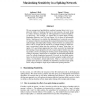Free Online Productivity Tools
i2Speak
i2Symbol
i2OCR
iTex2Img
iWeb2Print
iWeb2Shot
i2Type
iPdf2Split
iPdf2Merge
i2Bopomofo
i2Arabic
i2Style
i2Image
i2PDF
iLatex2Rtf
Sci2ools
NIPS
2004
2004
Maximising Sensitivity in a Spiking Network
We use unsupervised probabilistic machine learning ideas to try to explain the kinds of learning observed in real neurons, the goal being to connect abstract principles of self-organisation to known biophysical processes. For example, we would like to explain Spike TimingDependent Plasticity (see [5,6] and Figure 3A), in terms of information theory. Starting out, we explore the optimisation of a network sensitivity measure related to maximising the mutual information between input spike timings and output spike timings. Our derivations are analogous to those in ICA, except that the sensitivity of output timings to input timings is maximised, rather than the sensitivity of output `firing rates' to inputs. ICA and related approaches have been successful in explaining the learning of many properties of early visual receptive fields in rate coding models, and we are hoping for similar gains in understanding of spike coding in networks, and how this is supported, in principled probabi...
Input Spike Timings | NIPS 2004 | NIPS 2007 | Spike | Spike Timings |
| Added | 31 Oct 2010 |
| Updated | 31 Oct 2010 |
| Type | Conference |
| Year | 2004 |
| Where | NIPS |
| Authors | Anthony J. Bell, Lucas C. Parra |
Comments (0)

